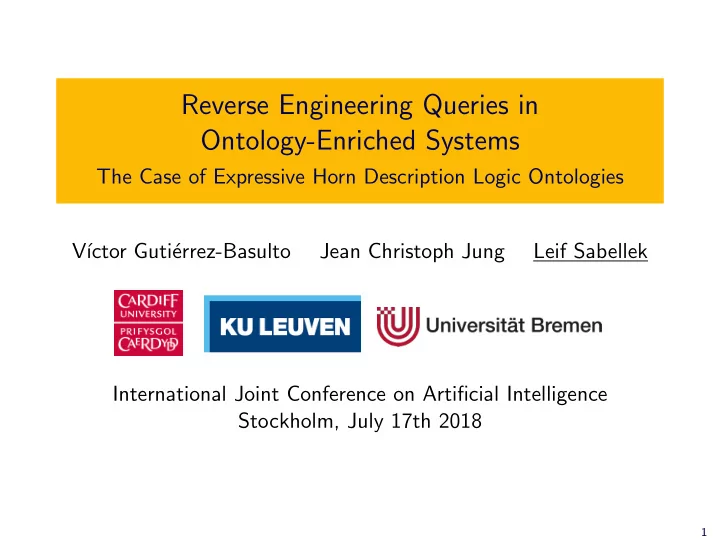

Reverse Engineering Queries in Ontology-Enriched Systems The Case of Expressive Horn Description Logic Ontologies V´ ıctor Guti´ errez-Basulto Jean Christoph Jung Leif Sabellek International Joint Conference on Artificial Intelligence Stockholm, July 17th 2018 1
Motivation Knowledge base Ontology Database They are both born in Sweden. What do Peter and Mary have in common? Non-expert user Unable to formulate conjunctive queries using the ontology 2
Query by example (QBE) Input : • a knowledge base ( T , A ) • a set of positive examples S + ⊆ dom( A ) n • a set of negative examples S − ⊆ dom( A ) n Question : Is there an n -ary query q that returns all the positive but none of the negative examples? We focus on conjunctive queries (CQ) q and Horn Description Logic Ontologies T . What do Peter and They are both either Mary have in common? Peter or Mary. 3
The case without ontology Idea : If there is a query that solves the problem, then the least general generalization lgg ( x ) is one. lgg ( x ) is constructed from the database and the positive examples. coNExpTime-Algorithm : • Construct lgg ( x ). • Verify that lgg ( x ) returns all positive examples. • Verify that lgg ( x ) return none of the negative examples. Theorem (ten Cate and Dalmau, 2015) The problem QBE( CQ ) (without ontology) is coNExpTime-complete. 4
Adding ontologies Construct the least general generalization lgg ∞ ( x ), using the universal model U T , A and the positive examples. lgg ∞ ( x ) is usually infinite, but: Theorem (Characterization) There is a solution for the QBE problem, if and only if: = lgg ∞ ( a ) for all a ∈ S + . • T , A | • T , A �| = lgg ∞ ( b ) for all b ∈ S − . 5
Main results L = Horn- ALCI Horn- ALC QBE( L , CQ) 2-ExpTime coNExpTime QBE( L , UCQ) ExpTime ExpTime QBE sig ( L , CQ) 2-ExpTime coNExpTime QBE sig ( L , UCQ) 2-ExpTime ExpTime Same results for the problem QDEF( L , (U)CQ), where the question is whether there is a query that returns precisely the positive examples. 6
Sizes of witness queries Theorem If there exists a witness query, then there is one of size • 2-exponential for QBE( Horn- ALC , CQ ) and • 4-exponential for QBE( Horn- ALCI , CQ ) . Theorem There is a family of instances for QBE( Horn- ALC , CQ ) , where the smallest witness queries are of 2-exponential size. 7
Conclusion Summary • QBE with Horn- ALC ontologies is not harder than without ontology. • Adding inverse roles makes the problem harder. • UCQs are easier but less interesting. Future work • Close the gaps for exact sizes of witness queries. • DL-Lite 8
Recommend
More recommend